
By NICOLAS RABENER
This research note on thematic funds was originally published by the CFA Institute’s Enterprising Investor blog. Here is the link.
Summary
- Thematic investing can be viewed as performance chasing with a narrative
- A systematic approach to thematic investing would have underperformed the stock market
- Thematic hedge fund managers have not generated attractive returns
Performance chasing with a narrative?
Thematic investing is like venture capital for asset managers. For every 10 products launched, most fail to generate interest from investors, a couple break even from a cost perspective, and maybe one becomes the star fund that raises billions of assets under management and makes it all worthwhile.
For example, the first cybersecurity-focused exchange-traded fund (ETF) – HACK – paid off for its manager when governments and corporations around the globe were attacked by hackers in June 2017.
Themes are typically about change: perhaps a country evolving from a frontier to an emerging market, a sector undergoing a dramatic transformation, or a new technology seeing widespread adoption. Of course, most investors are only interested in themes that generate enviable returns. Thematic investing isn’t just performance chasing, it’s performance chasing with a narrative. That can be a seductive combination.
So should investors consider thematic investing?
Selected thematic investments
Although there’s no standard definition, thematic investing tends to be about capturing the zeitgeist. Or trying to. The big themes of recent years have included factor investing; environmental, social, and governance (ESG) and low carbon investing; the rise of China; and new technologies like artificial intelligence (AI).
New themes appear all the time, but many are quickly forgotten, especially those that disappointed investors.
Some themes have a near-universal appeal, while others are more eclectic. Internet stocks were all the rage in 2000, but far fewer investors got into bitcoin and other cryptocurrencies in 2017 or marijuana stocks in 2018. In hindsight, themes can often resemble financial bubbles.
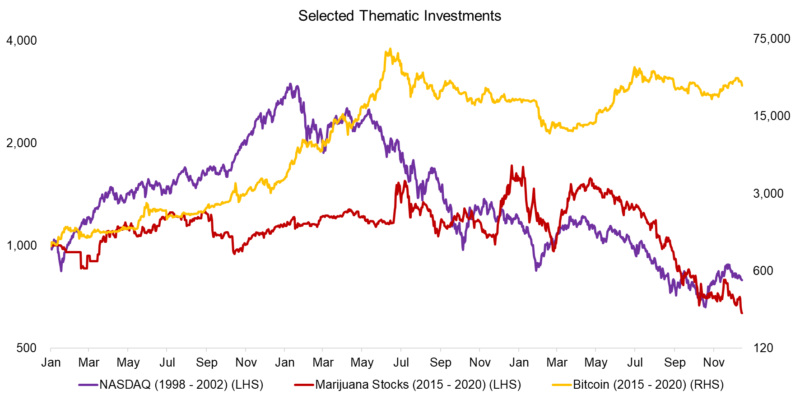
Source: FactorResearch.
In order to evaluate the attractiveness of thematic investing for investors, we need to be able to measure it. In the last 10 years there have been numerous large and small themes of various kinds, but deciding on what was a theme is a highly subjective process. Investing in technology stocks was a distinctive theme in 2000, but how about currently?
Perhaps the only way of identifying themes systematically is by performance. No matter how great the narrative about a frontier market or new technology is, it does not create excitement with investors unless accompanied by a chart highlighting great returns. Cryptocurrencies were ignored by investors, until millionaires were minted in legion.
Replicating thematic investing systematically
The Kenneth R. French Data Library has compiled daily returns for 49 industries in the United States going back to 1926. We used that data to replicate thematic investing systematically. We created one portfolio with a thematic allocation to the best-performing industry based on three-year performance, rebalancing annually, and another that allocates to the three best-performing sectors, which are equally weighted.
Both portfolios would have underperformed when benchmarked to an equal-weighted portfolio across all industries or the market-cap weighted stock market.
Once an industry outperforms, investors flock to it in a chase for performance, which often leads to expensive valuations. Eventually mean-reversion sets in, and with it less attractive subsequent returns.
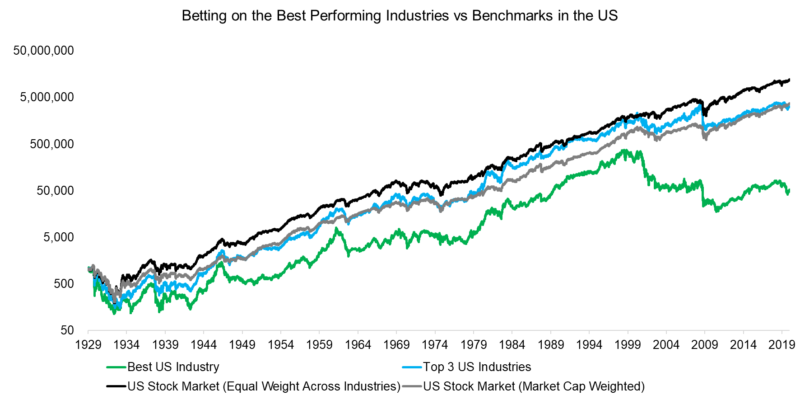
Source: Kenneth R. French, FactorResearch.
Although thematic investing’s relationship with performance chasing is intuitive, our approach – identifying themes based on three-year track records – is not without potential flaws. The lookback period may represent the industry standard for mutual fund and ETF performance evaluation, but maybe it is too short.
So let’s switch the perspective from returns to risk-adjusted returns: Allocations to the best-performing US industries, measured over three or five years, generated worse risk-return ratios from 1929 to 2019 than investing in the stock market. Performance chasing has not paid off.
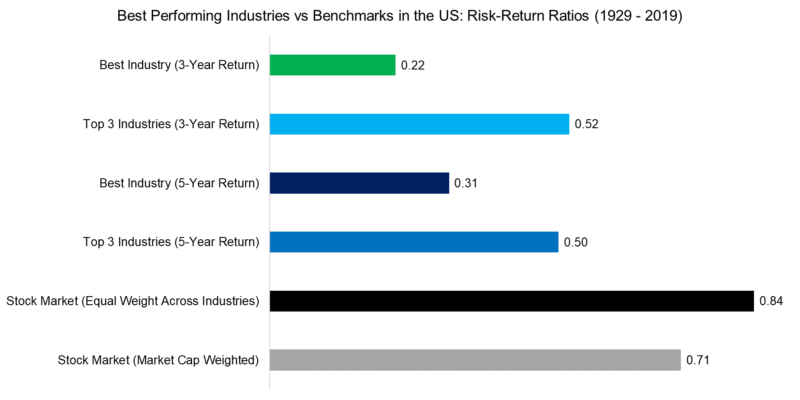
Source: Kenneth R. French, FactorResearch.
So what sectors performed the best most often over the last 90 years? There’s a diverse array that reflects the US economy’s evolution. Electronic equipment and health care have outperformed in recent decades. But coal and tobacco have most frequently topped the leaderboard.
Of course, these two sectors have fallen out of favour with investors of late, but they’ve played a considerable role in US equity market returns. ESG investing could not match their track record.
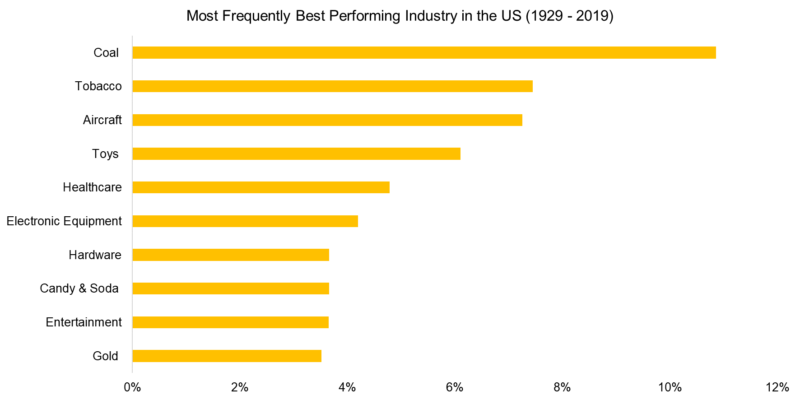
Source: Kenneth R. French, FactorResearch.
To be sure, this analysis is largely theoretical and therefore easily dismissed by thematic investing proponents. And we already pointed out the challenge of defining and measuring themes. But what about the track records of investors that specialise in thematic investing? What do they have to say about the overall utility of such approaches?
Thematic macro hedge fund managers have highly flexible mandates and can build portfolios of uncorrelated themes. Such themes might be expressed through long and short positions in equities, bonds, currencies, and commodities, among other asset classes. If anyone can make money from thematic investing, these unconstrained managers with their incentivised performance fees ought to be prime candidates.
But according to our analysis, their returns were anything but stellar. These managers were thematically wrong during the global financial crisis (GFC), with a 20% maximum drawdown. Since then, their returns are comparable to US investment-grade bonds.
This hardly makes the case for thematic investing. After all, hedge fund managers have access to more financial instruments and thus more opportunity to exploit themes than the average investor. The lack of performance is even more glaring given the assumed reporting biases of hedge fund indices. The returns from thematic macro investing are probably even worse than they appear.
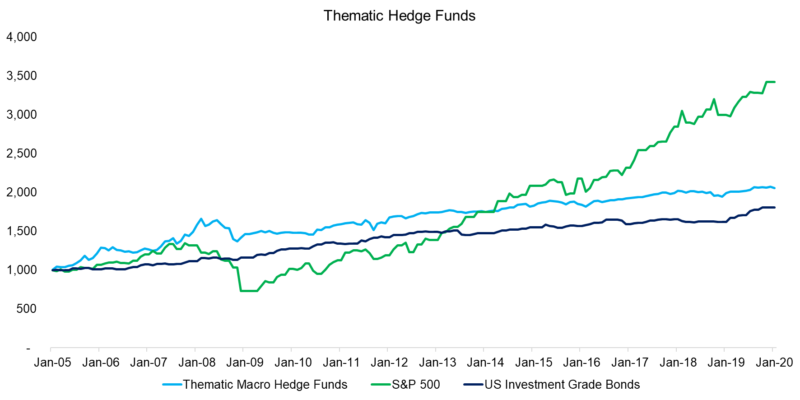
Source: HFRX, FactorResearch.
Further thoughts
There is no denying thematic investing’s appeal. Most investors would love to benefit from the growth of certain emerging countries, amazing new technologies, or even marijuana legalization in Canada and the United States.
But for thematic investing to work for investors, the trends must continue. While momentum strategies over one-year periods and combined with frequent rebalancing are backed up by academic research, there is scant evidence that plain-vanilla performance chasing works.
ESG and similar themes are forms of investing based on personal preference. They may come at a cost, but they achieve some non-financial objectives.
These exceptions aside notwithstanding, thematic investing is likely a bad theme for investors.
NICOLAS RABENER is the managing director of FactorResearch, which provides quantitative solutions for factor investing.









